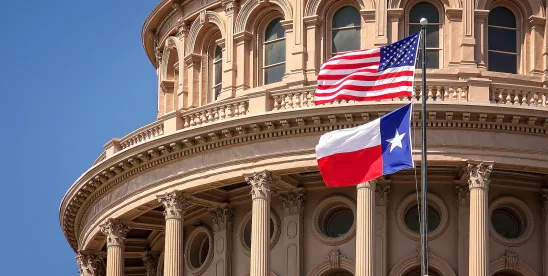Introduction
Electricity demand in Texas is growing at rates not seen in over 70 years, and is projected to continue increasing at unprecedented rates. This marked escalation is driven by population growth, electrification of oilfield operations and development of large industrial facilities, including data centers and manufacturing plants. As a result, developers of facilities with large electrical loads are facing longer waiting times to receive electrical service.
Lawmakers in Austin sought to address this issue in the recently concluded 89th Legislative Session with the passage of Texas Senate Bill 6 (SB 6) on May 29, 2025. Signed into law by Governor Abbott on June 20, 2025, SB 6 introduces new processes and requirements to be implemented by the Public Utility Commission of Texas (PUCT) and the Electric Reliability Council of Texas (ERCOT) that will significantly impact the interconnection process for large electrical loads within the region managed by ERCOT.
This law addresses five key issues:
- Interconnection standardization and cost sharing;
- Net metering arrangements for co-located facilities with existing generation;
- Curtailment of large load customers and creation of new demand response programs;
- Transmission cost allocation evaluation; and
- Water company electric generation.
Developers of facilities with large electrical loads, like manufacturing plants, oil and gas production, processing and refining facilities, cryptocurrency miners and data centers will be immediately impacted by SB 6.
Key Issue #1: Interconnection Standardization and Cost Sharing
SB 6 directs the PUCT to create, by rule, procedures for large load interconnections to the grid. The legislature defined large loads as being at least 75 megawatts (MWs) but allows the PUCT to lower this threshold. These procedures are to be designed in a manner to support business development, minimize the potential for stranded infrastructure costs, and maintain system reliability. The eventual rules put forth by PUCT will:
- Apply only to customers requesting a new or expanded large load interconnection where the total load at a single site would exceed the 75 MWs threshold, or a lower threshold as determined by the PUCT.
- Require these customers to disclose whether they are pursuing a substantially similar request for service elsewhere in the state, and whether the approval of that request would result in a customer changing, delaying, or withdrawing its most recent interconnection request.
- Require these customers to disclose information about whether it maintains on-site backup generation equal to or greater than half of the proposed load size, and that cannot be exported to the grid. In turn, ERCOT will develop a threshold before or during an energy emergency at which it may issue reasonable notice requiring large load customers with this type of backup generation to either deploy their backup generation or curtail the customer’s load, effectively reducing the customer’s grid-serviced load.
- Require each customer requesting interconnection to pay at least $100,000 to the interconnecting transmission provider for an initial transmission screening study, and allows additional fees to be charged if additional capacity is requested.
- Require large load customers to demonstrate site control for the proposed load location through an ownership interest, lease or other legal interest acceptable to the PUCT.
- Provide uniform financial commitment requirements for large load customers that may include security on a dollar per MW basis, a contribution in aid of construction, or security provided under an agreement that requires payment for upgrades in advance of signing any agreement that will establish the delivery of electric services.
- Provide for the potential reallocation of transmission capacity subject to outstanding financial commitments.
- Enable ERCOT to access customer information provided to the interconnecting transmission providers to ensure compliance with the requirements described above.
These standards will apply to interconnection agreements in effect on or after the effective date of SB 6. In addition to the standards implemented by the PUCT, SB 6 permits municipally owned utilities and electric cooperatives to impose additional requirements on large load customers requesting interconnections.
The PUCT, by rule, is also required to ensure that large load customers subject to these standards contribute to the recovery of an interconnecting utility’s costs to interconnect. Cooperatives and municipally owned utilities will be entitled to recover reasonable costs to interconnect with large load customers.
Key Issue #2: Net Metering Arrangements for Co-Located Facilities with Existing Generation
Beginning September 1, 2025, net metering arrangements between an existing generation resource and large load customer that will be co-located with the generation resource must be evaluated by ERCOT and approved by the PUCT. The operator of the applicable generation resource is required to submit a notice to ERCOT of any net metering arrangement before implementing such arrangement, after which ERCOT will be required to complete a study of the system impacts of the arrangement within 120 days. The PUCT is ultimately empowered to approve, deny, or impose reasonable conditions on the proposed arrangement as necessary to maintain system reliability, and must issue its decision within 60 days of receiving ERCOT’s study. The conditions that the PUCT may impose on any such arrangement may include certain dispatch requirements during anticipated emergency conditions, and holding other customers of the transmission provider harmless from stranded or underutilized transmission assets resulting from the net metering arrangement.
Transmission providers may object to these arrangements before the PUCT issues a final decision, but the only parties entitled to participate in a PUCT proceeding to address net metering arrangements are the PUCT, ERCOT, the transmission provider, and the parties to the net metering arrangement. Other stakeholders, such as environmental or community organizations, do not have standing to oppose any such net metering arrangements.
It is important to note that these requirements only apply to existing generation resources that intend to undertake a net-metering arrangement, thereby reducing the amount of existing generation capacity available to the grid. Generation facilities that are developed in the future and are co-located with a large load customer are not required to provide the aforementioned net metering notice to ERCOT and the PUCT.
Key Issue #3: Curtailment of Large Load Customers and Creation of New Demand Response Program
SB 6 also directs the PUCT and ERCOT to ensure that electric cooperatives, transmission and distribution utilities, and municipally-owned utilities to develop protocols for large loads interconnected after December 31, 2025 allowing these customers’ loads to be curtailed during emergencies. These protocols will include requirements that before a large load is interconnected, necessary equipment or technology must be installed that will allow ERCOT to directly curtail the customer’s load during firm load shed events and emergencies. Certain exceptions to this curtailment obligation will apply to “critical load industrial customers” and “critical natural gas facilities.”
In addition, SB 6 also directs the PUCT and ERCOT to develop a new reliability service that will competitively procure demand reductions from large loads during anticipated emergency conditions.
Key Issue #4: Transmission Cost Allocation Evaluation
SB 6 requires the PUCT to evaluate, within 90 days after the effective date of SB 6, the existing four coincident peak (or “4CP”) methodology used to charge wholesale transmission costs to distribution providers. If necessary, the PUCT will determine whether alternative methods to calculate wholesale transmission rates would more appropriately assign the costs of providing access to, and wholesale service from, the transmission system. Any rule changes resulting from this evaluation will occur no later than December 31, 2026.
Key Issue #5: Water and Sewer Company Electric Generation
SB 6 will allow certain water companies to generate electric power for their own operations and sell excess electric power into the ERCOT power region to provide revenue for their operations. This provision is limited to entities operating solely as a wholesale water supplier or sewer service in a county with a population of less than 350,000.
Implementation of SB 6 – Next Steps
SB 6 became effective immediately upon Governor Abbott signing it into law on June 20, 2025. The PUCT will begin implementing SB 6 through a series of rulemakings addressing the topics described above, including developing standards for interconnecting large loads, required contributions by large load customers for connecting to a transmission provider’s system, and protection of information submitted by large load customers to transmission providers. At the same time, ERCOT will be developing a new reliability service to competitively procure demand reductions from large loads while the PUCT evaluates transmission cost allocation.
Implications of SB 6
SB 6 changes the ways in which large loads will be interconnected to the Texas grid for transmission systems of investor-owned utilities, electric cooperatives, and municipally owned utilities. Co-located facilities with existing generation resources will now encounter their own new approval process. All large load customers will be forced to navigate not only interconnections to the Texas grid, but also operational changes during energy emergencies, a potential new cost allocation formula for transmission services, and disclosure of planned large load interconnections.
While the new law is intended to streamline the interconnection process for large loads, and thereby decrease interconnection waiting times, it also imposes new requirements and hurdles that will affect how developers of large loads design and implement their projects. At the same time, SB 6 also creates opportunities for large loads to take advantage of potential revenue sources through participation in the new reliability service.
SB 6 addresses growing concerns about availability of energy capacity to power large industrial development, specifically data centers. In the AI world, speed to energy is key to remaining competitive. Historically data centers relied on 100 percent uptime at peak load capacity as a core requirement of their development. However, AI workloads are not as consistent, requiring more energy during training workloads than during inference workloads. Moreover, it is possible to schedule AI training workloads or migrate computing power from one data center to another depending on operating conditions at one data center versus another. Though operators of generative AI models have not focused on efficiency and flexibility in their use of energy, laws like SB 6 may require a shift in thinking. As a result, large loads like data centers have the opportunity to pioneer creative arrangements to more efficiently utilize grid resources and ensure the United States remains at the forefront of technological development.
Notwithstanding SB 6’s focus on data center development, manufacturers with current and anticipated large electrical loads will also be significantly affected by the law. Developers will have to contend with the legislation’s new interconnection requirements and associated cost responsibilities, which could alter existing plans for connecting to and receiving service from the ERCOT grid. Likewise, operators of these facilities will also need to manage the new curtailment protocols for large loads, including how execution of curtailment directives will impact operational continuity during declared energy emergencies. However, these manufacturers can likewise participate in the new reliability service, which could mitigate effects on their businesses or create opportunities to generate additional revenue.
Importantly, the PUCT’s rulemaking process will allow the public numerous opportunities to shape how SB 6 will ultimately be implemented. Bracewell’s energy and infrastructure lawyers are available to answer any questions you may have as to how this law and the new regulations promulgated thereunder could affect your business, and how you can participate in influencing the outcome.




 />i
/>i

